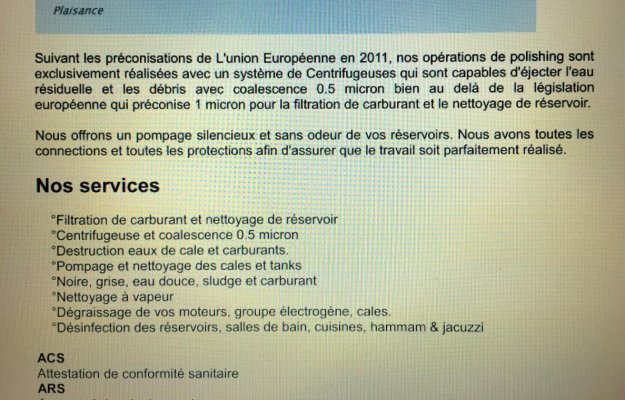Polishing is a broad term with no strict definition. Having personally cleaned out scores of diesel tanks, and supervised the cleaning of many more, I can make some broadly applicable observations, all of which apply strictly to diesel fuel.
Dockside polishing services, for the most part, clean the fuel but not the tank. Some claim that their wands and high pressure jets can clean a tank, but the fact is, if they can't enter every baffled chamber this is simply not possible. While there is value to dockside polishing, all filtration is good if it's removing contaminants, if the tanks are heavily contaminated, then the value of cleaning just the fuel is limited.
For older vessels, the accumulation of debris on tank bottoms can be considerable, especially if they sit idle for long periods, and in warm regions, where biological growth thrives. The accumulated bottom debris is usually a mixture of asphaltene, a naturally occurring contaminant in diesel, and the byproduct of water contamination. In the latter case, water supports biological growth, mostly bacteria and mold, contrary to popular belief it's not algae; algae needs light to carry out photosynthesis, and there's precious little of that inside a fuel tank. When the bacteria, which are microscopic animals, which have skeletons, which are abrasive, die their carcasses accumulate on the tank bottom. If this goes on for long enough, the accumulation can become quite deep. I've removed 3/4" thick "bio carpets" from tank bottoms that were contiguous sheets of this material, it's nasty.
Not only can this wreak havoc with the filters, bacteria produce a waste product that is acidic, which can attack metallic tanks. I've seen this process consume a tank bottom aboard a vessel that was just five years old, the inside bottom of the tank looked like the moon's surface, rough and pitted, the tanks had to be replaced. The bio-carpet also retains water against a tank bottom, which can cause poultice corrosion in aluminum tanks. It's a great argument for fiberglass diesel tanks. I've cleaned out 30 year old Hatteras FRP tanks that looked like new after the process was complete, something I can't say about most metallic tanks.
Therefore, if the tank is contaminated in this manner, polishing the fuel may be helpful, however, it's not a long term solution. Additionally, that debris may not be a problem, until the vessel finds herself in a seaway, where the washing machine effect stirs it up, and the fuel filters quickly clog.
Ideally, all fuel tanks should have inspection ports that allow access into each baffled chamber. Building a tank with these adds little cost, adding them after the fact is doable, but of course costs more. Every fuel tank I've ever designed and built includes clean out ports in every baffled chamber for these reasons. Additionally, the ideal tank would also include a water drain well, with a drain valve.
Clean out ports are available as kits (I have encountered some tank cleaning services that will install them, but that's rare, most just do the polishing), those from Sea-Built are reliable and well-designed, and if installed properly are leak-proof, I've used hundreds over the years.
The bottom line is, the dockside polishing service, while potentially useful, isn't s silver bullet for all tank contamination problems. If the tank bottom has a large accumulation of debris, fuel filter clogging will almost certainly continue, and it's likely to occur when the vessel is in a seaway, where this material is churned up by sloshing fuel. In those cases, the tank should be opened, adding inspection ports of necessary, and cleaned out thoroughly.
For such cleaning, if the accumulation is heavy, I've used a hot water pressure washer. This approach requires no solvents, and the interior of the tank need not be wiped down. The area around the tanks needs to be tented and placed under a slight vacuum using fans to extract fumes so they don't enter the boat. The oily water is pumped out of the tank during the wash process and allowed to settle, the diesel residue is sucked off the top and disposed of with fuel/oil waste.
Under no circumstances should oil absorbent pads be used inside a fuel tank, these shed fibers that are invisible when wet; which can accumulate and clog fuel valves, including Racor tandem selector valves, where they are very difficult to isolate and remove, as well as filters.


